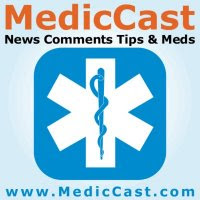
At the MedicCast Jamie Davis (the host of MedicCast) and Tom Bouthillet (of Prehospital 12 Lead ECG) followed up their interview of Dr. Monica Kleinman, incoming Chair of the Emergency Cardiovascular Care committee at the American Heart Association (Heart.org/cpr) that is posted in Emergency Cardiovascular Care 2010 Update Interview, with a podcast of the conversation that Jamie and Tom had after the end of the show with Dr. Kleinman posted at CPR ECC 2010 Updates with Tom Bouthillet and Episode 243. There is video, which includes PowerPoints of important supplemental information.
They start out discussing the field termination recommendations. I do not see termination guidelines as new. I see this as just an escalation of what they have been encouraging. Here is what the AHA included in the 2005 guidelines.
Terminating a Resuscitation in a BLS Out-of-Hospital System
Rescuers who start BLS should continue until one of the following occurs:
- Restoration of effective, spontaneous circulation and ventilation.
- Care is transferred to a more senior-level emergency medical professional who may determine that the patient is unresponsive to the resuscitation attempt.
- Reliable criteria indicating irreversible death are present.
- The rescuer is unable to continue because of exhaustion or the presence of dangerous environmental hazards or because continuation of resuscitative efforts places other lives in jeopardy.
- A valid DNAR order is presented to rescuers.
Defibrillators are required standard equipment on ambulances in most states, so the absence of a “shockable” rhythm on the defibrillator after an adequate trial of CPR can be the key criterion for withdrawing BLS in the absence of timely arrival of ACLS. State or local EMS authorities must develop protocols for initiation and withdrawal of BLS in areas where ACLS is not rapidly available or may be significantly delayed. Local circumstances, resources, and risk to rescuers should be considered.[1]
The first field pronouncement I was involved in was in 1991. Found down. Asystole. 45 minute code. The On Line Medical Command doctor agreed that the patient would not benefit from transport.
The current termination criteria are just a logical continuation of what the AHA was already encouraging.
This is not a surprising new position.
What did the AHA have to say about the ethics of mega-decibel high speed relocation of dead people?
Transport of Patients in Cardiac Arrest
If an EMS system does not allow nonphysicians to pronounce death and stop resuscitative efforts, personnel may be forced to transport to the hospital a deceased victim of cardiac arrest who proved to be refractory to proper BLS/ACLS care. Such an action is unethical.This situation creates the following dilemma: if carefully executed BLS and ACLS treatment protocols fail in the out-of-hospital setting, then how could the same treatment succeed in the emergency department? A number of studies have consistently observed that <1% of patients transported with continuing CPR survive to hospital discharge.
Delayed or token efforts, a so-called "slow-code" (knowingly providing ineffective resuscitation), that appear to provide CPR and ACLS are inappropriate. This practice compromises the ethical integrity of healthcare providers and undermines the physician-patient/nurse-patient relationship.
Many EMS systems authorize the termination of a resuscitation attempt in the out-of-hospital setting. Protocols for pronouncement of death and appropriate transport of the body by non-EMS vehicles should be established. EMS personnel must be trained to focus on dealing sensitively with family and friends.[2]
Again, this is what the 2005 guidelines state –
If an EMS system does not allow nonphysicians to pronounce death and stop resuscitative efforts, personnel may be forced to transport to the hospital a deceased victim of cardiac arrest who proved to be refractory to proper BLS/ACLS care.
Such an action is unethical.
How can medical directors justify ignoring the 2005 AHA guidelines?
Everybody dead gets epi is a guideline that medical directors refuse to violate.
Compassionate care is a guideline medical directors refuse to obey.
Why?
Both are from the same guidelines.
–
Maybe we think that transport is more important than quality of compressions.
That is wrong.
Maybe we think that we can provide high quality compressions during transport.
That is a lie.
–
A lack of training in grief counselling is not a reason to play high speed musical chairs with dead people.
A lack of training in grief counselling is a reason to initiate training in grief counselling.
For medical directors to require that EMS force high cost, high risk, high decibel, high speed transport of family members, rather than provide compassionate care is not defensible.
Go listen to the podcast. There is more there that I will write about.
–
Footnotes:
–
[1] Terminating a Resuscitation in a BLS Out-of-Hospital System
2005 American Heart Association Guidelines for Cardiopulmonary Resuscitation and Emergency Cardiovascular Care
Part 2: Ethical Issues
Issues Related to Out-of-Hospital Resuscitation
Free Full Text Article with links to Free Full Text PDF download
–
[2] Transport of Patients in Cardiac Arrest
2005 American Heart Association Guidelines for Cardiopulmonary Resuscitation and Emergency Cardiovascular Care
Part 2: Ethical Issues
Issues Related to Out-of-Hospital Resuscitation
Free Full Text Article with links to Free Full Text PDF download
.


[…] This post was mentioned on Twitter by Jason (JT) Thompson, EMS Blogs. EMS Blogs said: From #RogueMedic: More Podcasting on the 2010 AHA Guidelines – Part I http://bit.ly/bWYYWr #EMS #Blog #EMSBlogs […]